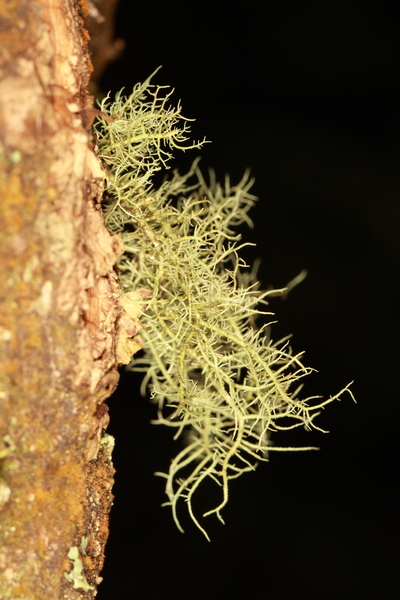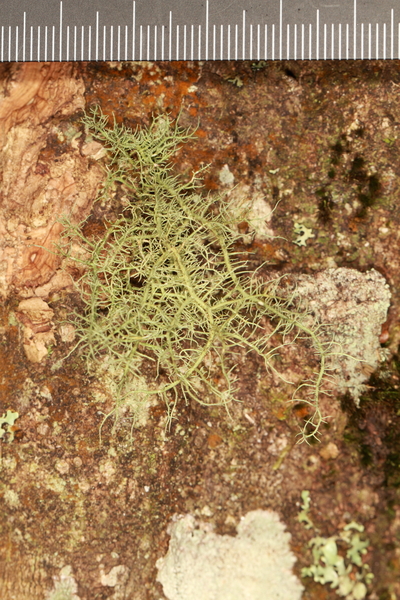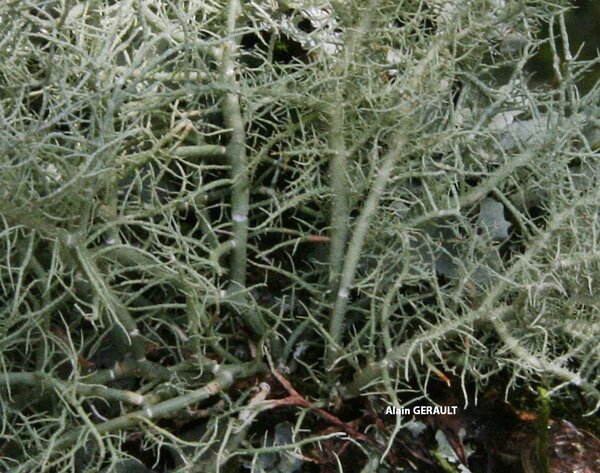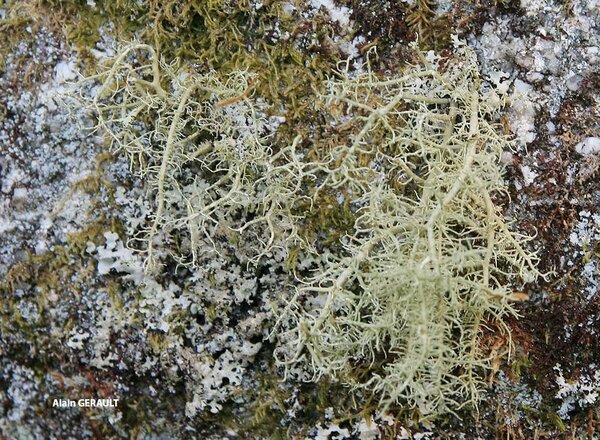Usnea cornuta Körb.
Parerga Lichenol.: 2, 1865.
Synonyms: Usnea confusa Asahina; Usnea constrictula Stirt.; Usnea inflata (Duby) Motyka; Usnea inflata var. cornuta (Körb.) Clauzade & Cl. Roux; Usnea intexta Stirt.; Usnea subpectinata Stirt.
Distribution: N - Frl, TAA (Nascimbene & al. 2007b), Lig. C - Tosc, Sar (Ravera & al. 2024a). S - Camp, Cal (Brackel & Puntillo 2016), Si (Ravera & al. 2024).
Description: Thallus fruticose-filamentous, greenish, usually shrubby, 3-7(-10) cm long, the branching sympodial, mainly anisotomic-dichotomous with divergent branches. Main branches to 1.5 mm thick, tapering to fusiform, with numerous annular cracks which divide the branch into cylindrical to sausage-like, terete segments, the base pale to black; lateral branches distinctly constricted at attachment point, the terminal branches arranged at right angles to the secondary branches. Papillae and tubercles few to numerous, most dense on secondary branches; fibrils irregularly distributed but usually numerous on main branches close to the basal part, spinulose, up to 3 mm long. Soralia most numerous on terminal branches (last third of thallus length), crowded (30-50 soralia/mm2), mainly developing from the cortex on secondary and terminal branches, flat and irregular in outline, initially punctiform (50-200 µm across) and occupying less than the half of the diameter of the branch, but later often confluent and resembling a single large soralium, often with 0.1–0.2 mm long, clustered isidiomorphs when young. Cortex thin to moderately thick (5–9% of total branch thickness), vitreous in longitudinal section; medulla heterogeneous, with a narrow compact ring below the cortex, otherwise lax to dense, rather thick (25–37%), white; central axis white to pale orange or pink, thin to moderately thick (15–35%); ratio axis/medulla ranging between 0.4 and 1.2. Apothecia very rare, lecanorine, to 5 mm across. Asci 8-spored, Lecanora-type. Ascospores 1-celled, hyaline, ellipsoid. Photobiont chlorococcoid. Spot tests: cortex K-, C-, KC-, P-; medulla K+ yellow, orange or blood-red, rarely K-, C-, KC-, P+ yellow or orange, very rarely P-. Chemistry: cortex with usnic acid; the medulla of the most frequent chemotype with stictic acid, variable amounts of norstictic acid, plus several accessory substances of the stictic acid complex; a rare chemotype contains salazinic and constictic acids, and a very rare chemotype is devoid of medullary substances.
Note: a chemically and morphologically variable epiphytic species also occurring on siliceous rocks, restricted to damp sites with frequent fog, mostly in the montane belt. It is included in the Italian red list of epiphytic lichens as “Endangered” (Nascimbene & al. 2013c).
Growth form: Fruticose filamentous
Substrata: bark and rocks
Photobiont: green algae other than Trentepohlia
Reproductive strategy: mainly asexual, by soredia, or soredia-like structures (e.g. blastidia)
Restricted to humid-warm, oceanic areas
Commonnes-rarity: (info)
Alpine belt: absent
Subalpine belt: absent
Oromediterranean belt: absent
Montane belt: very rare
Submediterranean belt: absent
Padanian area: absent
Humid submediterranean belt: extremely rare
Humid mediterranean belt: absent
Dry mediterranean belt: absent
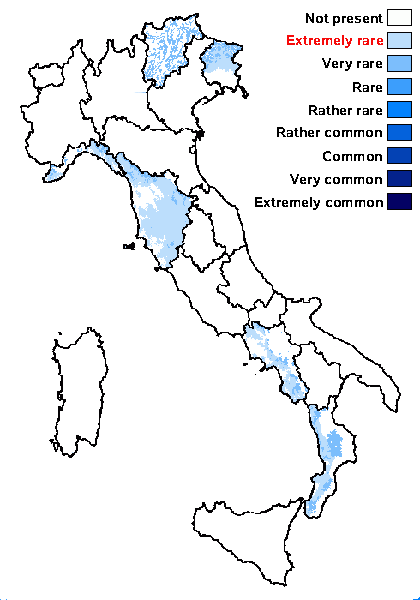
Predictive model
Herbarium samples
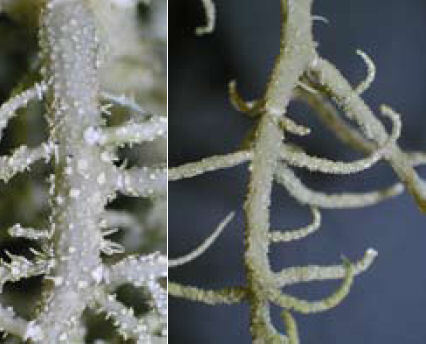
Tiiu Tõrra; Owner: Tiiu Tõrra - Institute of Ecology and Earth Sciences, University of Tartu, Estonia
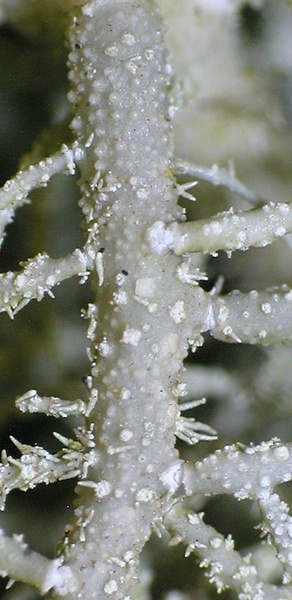
Tiiu Tõrra; Owner: Tiiu Tõrra - Institute of Ecology and Earth Sciences, University of Tartu, Estonia
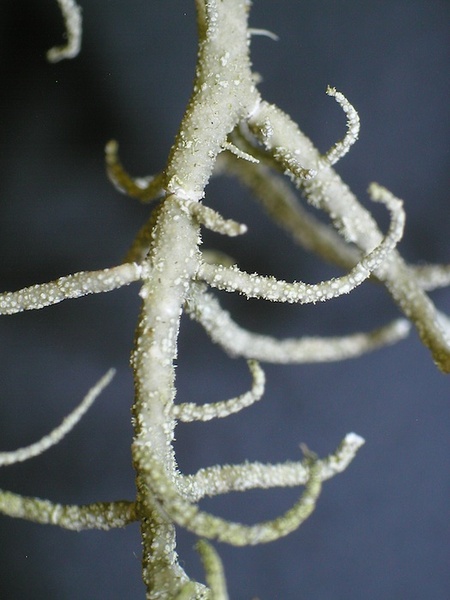
Tiiu Tõrra; Owner: Tiiu Tõrra - Institute of Ecology and Earth Sciences, University of Tartu, Estonia
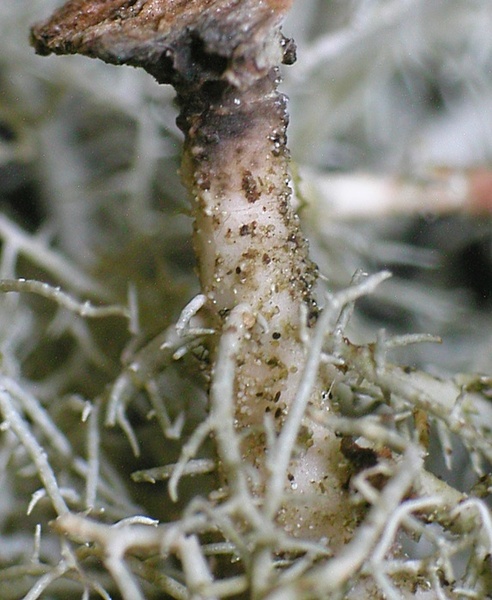
Tiiu Tõrra; Owner: Tiiu Tõrra - Institute of Ecology and Earth Sciences, University of Tartu, Estonia

Tiiu Tõrra; Owner: Tiiu Tõrra - Institute of Ecology and Earth Sciences, University of Tartu, Estonia
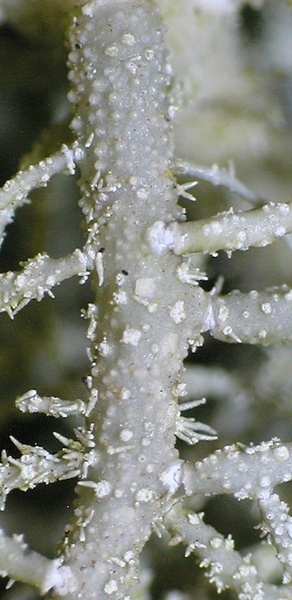
Tiiu Tõrra; Owner: Tiiu Tõrra - Institute of Ecology and Earth Sciences, University of Tartu, Estonia
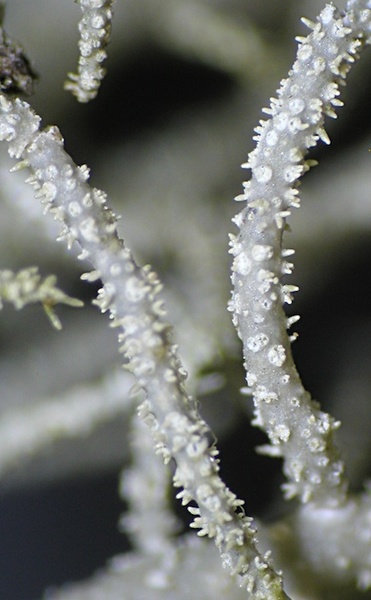
Tiiu Tõrra; Owner: Tiiu Tõrra - Institute of Ecology and Earth Sciences, University of Tartu, Estonia

Tiiu Tõrra; Owner: Tiiu Tõrra - Institute of Ecology and Earth Sciences, University of Tartu, Estonia
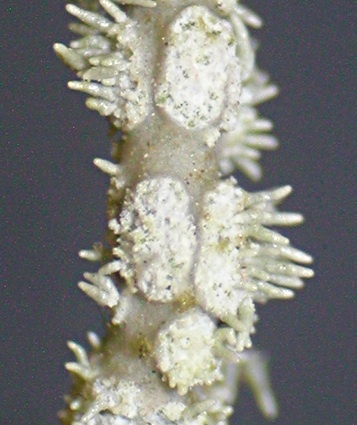
Tiiu Tõrra; Owner: Tiiu Tõrra - Institute of Ecology and Earth Sciences, University of Tartu, Estonia
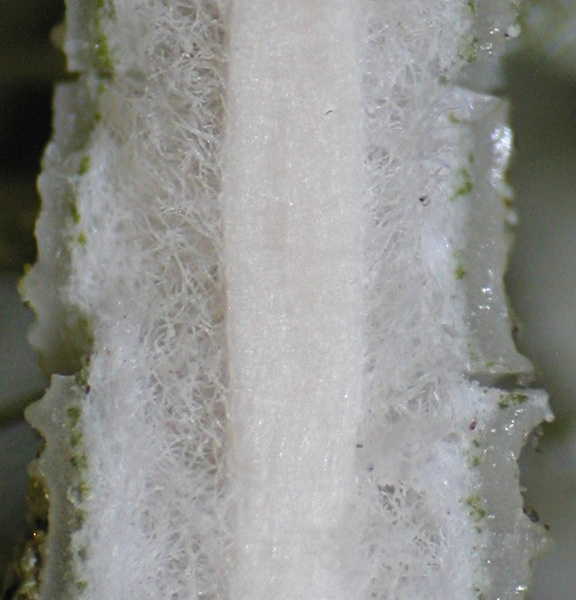
Tiiu Tõrra; Owner: Tiiu Tõrra - Institute of Ecology and Earth Sciences, University of Tartu, Estonia
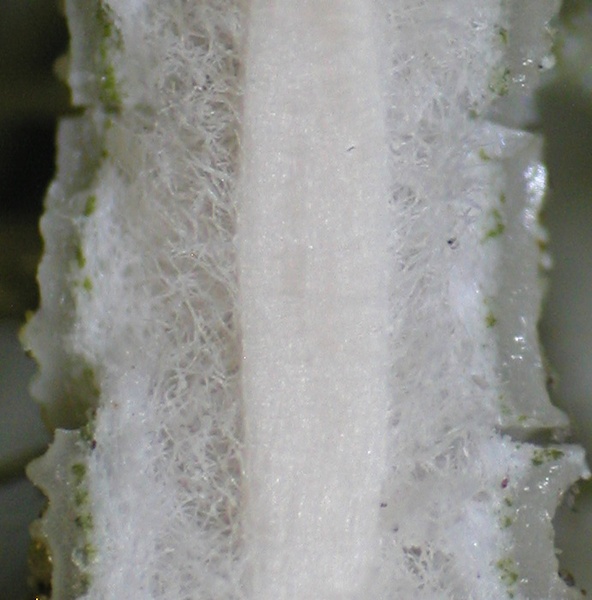
Tiiu Tõrra; Owner: Tiiu Tõrra - Institute of Ecology and Earth Sciences, University of Tartu, Estonia
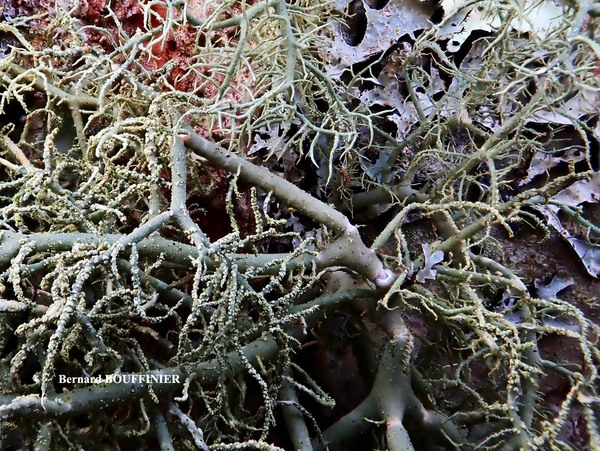
Bernard Bouffinier - Source: http://www.lichensmaritimes.org/index.php?task=fiche&lichen=660&lang=en
France, Camaret
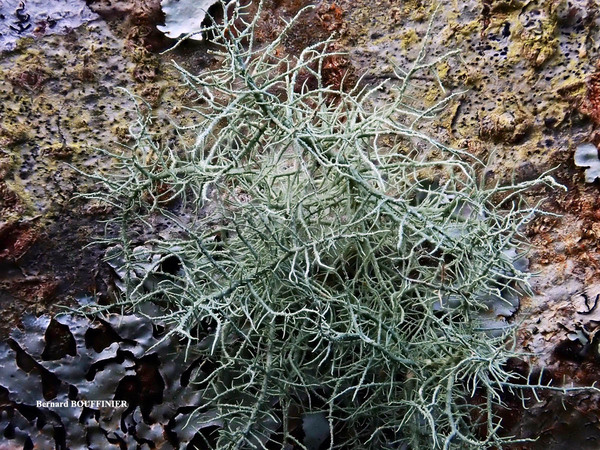
Bernard Bouffinier - Source: http://www.lichensmaritimes.org/index.php?task=fiche&lichen=660&lang=en
France, Camaret

Bernard Bouffinier - Source: http://www.lichensmaritimes.org/index.php?task=fiche&lichen=660&lang=en
France, Le Relecq
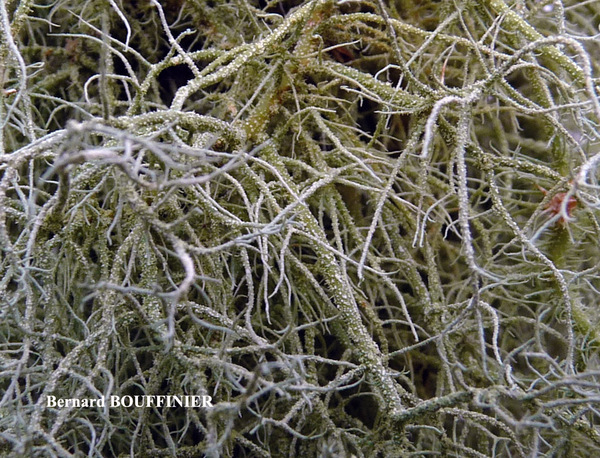
Bernard Bouffinier - Source: http://www.lichensmaritimes.org/index.php?task=fiche&lichen=660&lang=en
France, Hôpital-Camfrou
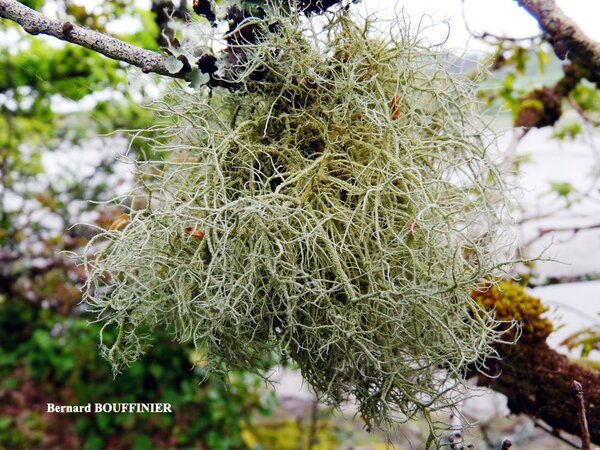
Bernard Bouffinier - Source: http://www.lichensmaritimes.org/index.php?task=fiche&lichen=660&lang=en
France, Hôpital-Camfrou

Michel David - Source: http://www.lichensmaritimes.org/index.php?task=fiche&lichen=660&lang=en
France, Roc'h Cléguer
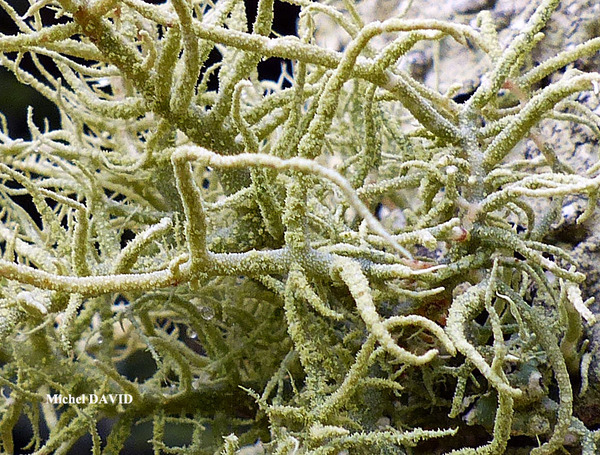
Michel David - Source: http://www.lichensmaritimes.org/index.php?task=fiche&lichen=660&lang=en
France, Roc'h Cléguer
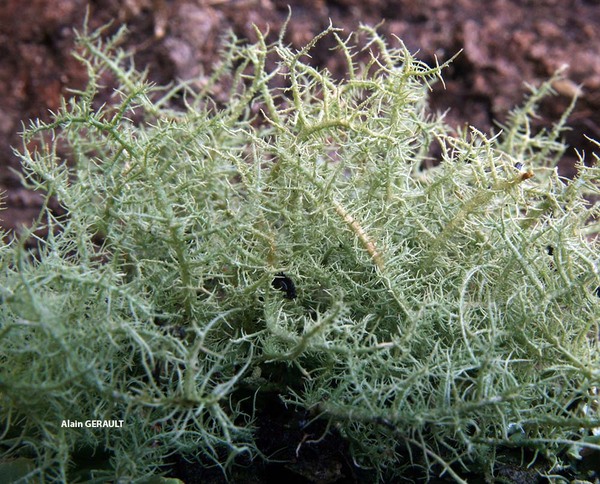
Alain Gerault - Source: http://www.lichensmaritimes.org/index.php?task=fiche&lichen=660&lang=en
France, Cranou
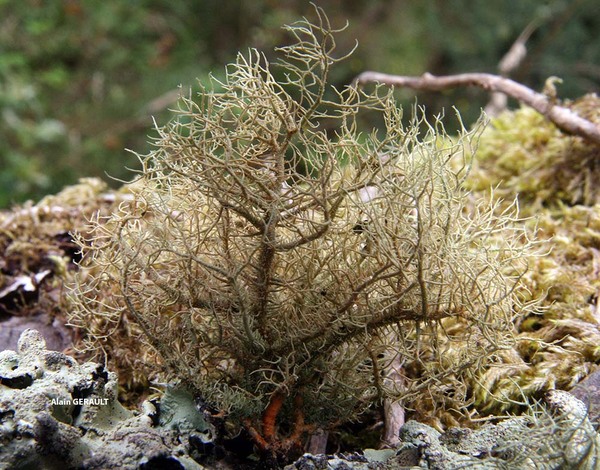
Alain Gerault - Source: http://www.lichensmaritimes.org/index.php?task=fiche&lichen=660&lang=en
France, Huelgoat
Growth form: Fruticose filamentous
Substrata: bark and rocks
Photobiont: green algae other than Trentepohlia
Reproductive strategy: mainly asexual, by soredia, or soredia-like structures (e.g. blastidia)
Restricted to humid-warm, oceanic areas
Commonnes-rarity: (info)
Alpine belt: absent
Subalpine belt: absent
Oromediterranean belt: absent
Montane belt: very rare
Submediterranean belt: absent
Padanian area: absent
Humid submediterranean belt: extremely rare
Humid mediterranean belt: absent
Dry mediterranean belt: absent

Predictive model
| Herbarium samples |

Tiiu Tõrra; Owner: Tiiu Tõrra - Institute of Ecology and Earth Sciences, University of Tartu, Estonia

Tiiu Tõrra; Owner: Tiiu Tõrra - Institute of Ecology and Earth Sciences, University of Tartu, Estonia

Tiiu Tõrra; Owner: Tiiu Tõrra - Institute of Ecology and Earth Sciences, University of Tartu, Estonia

Tiiu Tõrra; Owner: Tiiu Tõrra - Institute of Ecology and Earth Sciences, University of Tartu, Estonia

Tiiu Tõrra; Owner: Tiiu Tõrra - Institute of Ecology and Earth Sciences, University of Tartu, Estonia

Tiiu Tõrra; Owner: Tiiu Tõrra - Institute of Ecology and Earth Sciences, University of Tartu, Estonia

Tiiu Tõrra; Owner: Tiiu Tõrra - Institute of Ecology and Earth Sciences, University of Tartu, Estonia

Tiiu Tõrra; Owner: Tiiu Tõrra - Institute of Ecology and Earth Sciences, University of Tartu, Estonia

Tiiu Tõrra; Owner: Tiiu Tõrra - Institute of Ecology and Earth Sciences, University of Tartu, Estonia

Tiiu Tõrra; Owner: Tiiu Tõrra - Institute of Ecology and Earth Sciences, University of Tartu, Estonia

Tiiu Tõrra; Owner: Tiiu Tõrra - Institute of Ecology and Earth Sciences, University of Tartu, Estonia

Bernard Bouffinier - Source: http://www.lichensmaritimes.org/index.php?task=fiche&lichen=660&lang=en
France, Camaret

Bernard Bouffinier - Source: http://www.lichensmaritimes.org/index.php?task=fiche&lichen=660&lang=en
France, Camaret

Bernard Bouffinier - Source: http://www.lichensmaritimes.org/index.php?task=fiche&lichen=660&lang=en
France, Le Relecq

Bernard Bouffinier - Source: http://www.lichensmaritimes.org/index.php?task=fiche&lichen=660&lang=en
France, Hôpital-Camfrou

Bernard Bouffinier - Source: http://www.lichensmaritimes.org/index.php?task=fiche&lichen=660&lang=en
France, Hôpital-Camfrou

Michel David - Source: http://www.lichensmaritimes.org/index.php?task=fiche&lichen=660&lang=en
France, Roc'h Cléguer

Michel David - Source: http://www.lichensmaritimes.org/index.php?task=fiche&lichen=660&lang=en
France, Roc'h Cléguer

Alain Gerault - Source: http://www.lichensmaritimes.org/index.php?task=fiche&lichen=660&lang=en
France, Cranou

 Index Fungorum
Index Fungorum
 GBIF
GBIF
